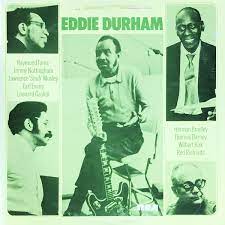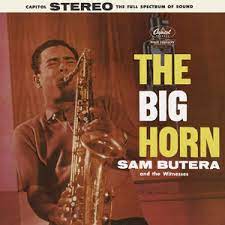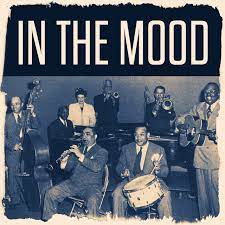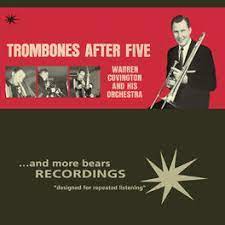
Daily Dose Of Jazz…
Edward Durham was born on August 19, 1906 in San Marcos, Texas to Joseph Durham, Sr., and Luella Rabb Durham. From an early age he performed with his family in the Durham Brothers Band. At the age of eighteen, he began traveling and playing in regional bands.
From 1929 Eddie started experimenting to enhance the sound of his guitar using resonators and megaphones. In 1935 he was the first to record an electrically amplified guitar with Jimmie Lunceford in Hittin’ the Bottle that was recorded in New York for Decca.
In 1938, Durham wrote I Don’t Want To Set The World On Fire with Bennie Benjamin, Sol Marcus, and Eddie Seiler. During the 1940s he created Eddie Durham’s All-Star Girl Orchestra, an all black female swing band that toured the United States and Canada.
That same year Eddie recorded single string electric guitar solos with the Kansas City Five or Six, which were both smallish groups that included members of Count Basie’s rhythm section along with the tenor saxophone playing of Lester Young. The orchestras of Bennie Moten, Jimmie Lunceford, Count Basie and Glenn Miller took great benefit from his composing and arranging skill.
Guitarist, trombonist, composer and arranger Eddie Durham, who was one of the pioneers of the electric guitar in jazz, transitioned on March 6, 1987.
More Posts: arranger,guitar,history,instrumental,jazz,music,trombone

Daily Dose Of Jazz…
Sam Butera was born on August 17, 1927 and raised in an Italian-American family in New Orleans, Louisiana where his father ran a butcher shop and played guitar in his spare time. Hearing the saxophone at seven for the first time at a wedding, with his father’s encouragement he began to play.
His professional career blossomed early, beginning with a stint in big band drummer Ray McKinley’s orchestra directly after high school. At eighteen Butera was named one of America’s top upcoming jazzmen by Look magazine and by his early twenties, he had landed positions in the orchestras of Tommy Dorsey, Joe Reichman, and Paul Gayten.
As the big band era wound down Sam re-settled in New Orleans, where he played regularly at the 500 Club for four years. The club, owned by Louis Prima’s brother, was the connection that led him to his Las Vegas, Nevada collaborations with Prima and Keely Smith.
Prima transitioned from big band to Vegas and the Sahara and called Butera to assemble a band posthaste. They drove from New Orleans to Las Vegas and without a name on opening night in 1954 when Prima asked Butera before a live audience he responded spontaneously, “The Witnesses”, and the name stuck, remaining the bandleader for more than twenty years.
Noted for his raucous playing style, his off-color humor, and the innuendo in his lyrics, he also wrote arrangements, composed music. Sam is widely regarded as the inspiration for the vocal style of fellow New Orleans-born jazz singer Harry Connick, Jr. He went on to appear on television and in movies. Tenor saxophonist Sam Butera transitioned from pneumonia in Las Vegas on June 3, 2009 at the age of 81.
More Posts: arranger,bandleader,composer,history,instrumental,jazz,music,saxophone

Daily Dose Of Jazz…
Joseph Copeland Garland was born on August 15, 1903 in Norfolk, Virginia and studied music at Shaw University and the Aeolian Conservatory. He started by playing classical music but joined a jazz band, Graham Jackson’s Seminole Syncopators, in 1924, where he first recorded.
He had a long run of associations as a sideman on saxophone and clarinet from 1925 to the end of the decade with Elmer Snowden, Joe Steele, Henri Saparo, Leon Abbey Charlie Skeete and Jelly Roll Morton. By the 1930s he was playing and arranging with Bobby Neal and the Mills Blue Rhythm Band from 1932 to 1936. When Lucky Millinder replaced him, he joined Edgar Hayes in 1937, then Don Redman the following year, and Louis Armstrong from 1939 to 1942.
In the 1940s, he played with Claude Hopkins and others, and then returned to Armstrong’s band mid decade for two years. Following this he played with Herbie Fields, Hopkins again, and Earl Hines. In the 1950s, he went into semi-retirement.
Garland wrote a number of well-known swing jazz hits, including Serenade To A Savage and Leap Frog. He is credited as the composer with lyricist Andy Razaf for In the Mood which became a Glenn Miller hit. Saxophonist, composer, and arranger Joe Garland transitioned on April 21, 1977 in Teaneck, New Jersey.
More Posts: arranger,clarinet,composer,history,instrumental,jazz,music,saxophone

Daily Dose Of Jazz…
Wik Horn was born on August 9, 1943 in Amsterdam, Netherlands. Classically trained piano education for 4 years starting at 10, when he was 14 he started to play classic jazz with his younger brother trumpeter Fred.
After playing in several school bands he formed his first real band in 1965,The Court Town Rhythm Kings. The band played authentic old jazz in the way of Oliver, Morton, early Armstrong, Williams, Beiderbecke and Half Way House.
The band broke up in 1972 due to moving members and Wik moved from The Hague to resettle in Amsterdam. There along with his brother they founded in 1973 as Madam Zenja and Her Jazz Horns in 1973, together with singer Zenja Damm, recording two albums, Changes and Was It A Dream. From 1974 to 1980 he was president of the oldest and famous Jazzclub in Holland, the Haarlemse Jazz Club. Many of the great American musicians who came to Europe and Amsterdam performed there.
Settling in the little village of Leiderdorp between Amsterdam and The Hague, he spent some time in advertising and public relations. He started the jazz club De Wagenschuur from 1984 to 1994 and a new band, Swingin’ Crash, that started as a little swing ensemble but grew within a year into a small big band.
He went on to write charts and arrangements for the band and well as compose, song texts and write a little booklet for special occasions like the 60th anniversary of the The Hague Jazz Club. Pianist Wik Horn retired but has continued to have a life filled with music, writing and painting.
More Posts: arranger,bandleader,composer,history,instrumental,jazz,music,piano

Daily Dose Of Jazz…
Warren Covington was born on August 7, 1921 in Philadelphia, Pennsylvania and played with Isham Jones in 1939, then with Les Brown in 1945-46 and Gene Krupa in late 1946. Following this he became a staff musician for CBS radio.
By the end of the decade he was working with Ralph Flanagan and again in the mid Fifties. He played briefly with Tommy Dorsey but by 1956 he replaced Eddie Grady as leader of the Commanders, a Decca recording and touring band which lasted until the middle of 1957. Covington recorded two albums and one single with this band.
Post Tommy Dorsey’s sudden death in 1956, the band continued under the direction of Jimmy Dorsey. However, Tommy’s estate took back his arrangements and approached Warren to form a new Tommy Dorsey band, which he led, touring and recording for Decca, into 1961. Among his hits with the Dorsey band was Tea for Two Cha Cha, which sold over one million copies and was awarded a gold disc.
A player who also occasionally played, with a variety of the baritone horn, baritone and tenor saxophone, Covington participated in the big bands of Charles Mingus, Randy Weston, Bobby Hackett, and George Benson on recordings, and also a number of film soundtracks.
Big band trombonist Warren Covington, who was also an active session player, arranger and bandleder, transitioned on August 24, 1999 in New York.
More Posts: arranger,bandleader,history,instrumental,jazz,music,trombone


